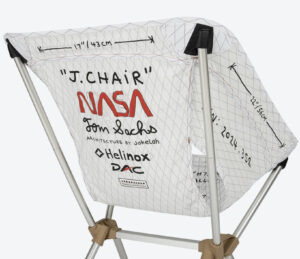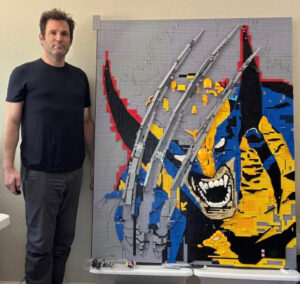In a culture increasingly drawn to the intersection of design, performance, and storytelling, few objects achieve the rare status of becoming both functional gear and cultural artifact. The Tom Sachs J-Chair by Helinox, a limited-edition release, belongs to that exclusive category. Crafted from DAC aluminum and deeply influenced by Sachs’ fascination with space exploration, the chair is not merely a piece of outdoor furniture—it is a meditation on engineering, identity, and the ethos of movement. In its every joint and panel lies an ode to craftsmanship and an expression of cosmic ambition.
This 2025 capsule is not the first encounter between Helinox and the design world, but it is perhaps the most deliberate in terms of narrative cohesion. With the J-Chair, both brands fuse their guiding philosophies: Helinox’s pursuit of ultralight, durable, and portable gear, and Sachs’ artistic devotion to manuality, ritual, and the mythos of NASA. The result is an object that feels paradoxically utilitarian and sacred—a chair built for the campsite, the studio, or the launch pad.
An Homage to Jake Lah and DAC Engineering Excellence
The J-Chair’s bones are constructed from DAC aluminum alloy, the proprietary material developed by Helinox founder Jake Lah’s engineering team. DAC (Dongah Aluminum Corporation), based in South Korea, has quietly been supplying the backbone of the world’s best tent poles and outdoor structures for decades. Lah’s obsession with weight distribution, joint strength, and minimalist design transformed what was once overlooked gear into aspirational objects.
Sachs, ever an admirer of industrial processes, found in DAC the unique partner. The J-Chair’s skeletal frame—with its smooth curves, matte finish, and sculptural form—reads like a homage not only to aerospace architecture but to Jake Lah’s legacy. With precision-milled hubs and ultralight tubes, the chair upholds Helinox’s mandate: gear that performs in the wild, but looks just as at home in a museum or concept studio.
At 2.5 pounds (roughly 1.1 kg), the J-Chair achieves that essential tension between reduction and endurance. It can support over 300 pounds yet folds into a compact roll no larger than a yoga mat. This is not a seat designed for idleness; it is a platform for process—a throne for thinkers, makers, and wanderers alike.
Tom Sachs: Ritual Over Randomness
The New York-based artist Tom Sachs is best known for his hand-hewn approach to making. In a world addicted to smoothness and automation, Sachs reclaims the imperfect, the tactile, the visibly labored. His pieces—whether they be a plywood recreation of a NASA rover or a bricolage toilet for a fictional Mars base—exude a tactile sincerity.
For Sachs, every screw counts, and every label tells a story. In that sense, the J-Chair is as much sculpture as it is equipment. Each chair is hand-labeled with Sachs’ signature block-lettering, the kind familiar to collectors of his Space Program series. Across the fabric backrest, the words “Always Be Knolling” are stenciled—a nod to Sachs’ famously codified studio rules. Knolling, the act of arranging objects in parallel or 90-degree angles, becomes not just a work habit, but a metaphor for the orderliness of exploration.
The seat pan includes additional Sachs-approved markings: coordinates, serialized numbers, and modular cues that lend the object an air of engineering document rather than product. These aren’t embellishments—they are the syntax of his ideology. One might liken sitting in the J-Chair to donning a lab coat in a lunar module: it prepares the user for a ceremony of action.
NASA’s Backdrop: Form and Function in Orbital Design
Though Sachs’ involvement makes the chair unmistakably artistic, its references are deeply functional. The J-Chair echoes the shape and ergonomics of mission-critical seating, from lunar lander cockpits to control-room stools. The upright frame, braced by reinforced joints, mimics the industrial cadence of zero-gravity furnishings. The canvas used in the seat cover is flame-retardant, dust-resistant, and printed with monochrome warnings in Helvetica Bold—functional typography lifted from aerospace signage.
There is something unapologetically brutalist about the J-Chair. While comfort is never sacrificed, the visual vocabulary signals discipline. This is not a lounger for the idle but a tool for the focused. Even its deployable frame, which clicks into place with satisfying precision, recalls the field-tested snap of military-grade gear. Indeed, Sachs’ admiration for NASA and the aesthetics of government-issue equipment is no secret—he once described NASA as “the ultimate brand.”
Sitting in the J-Chair, you don’t just rest—you occupy a position. You become, even if momentarily, part of a continuum of astronauts, scientists, artists, and nomads.
The Limited Edition Ethos: Value Beyond Rarity
There’s a temptation to interpret the J-Chair through the lens of scarcity. Limited to a few hundred units globally, the product bears all the hallmarks of exclusivity: serialized stamping, certificate of authenticity, and a rollout timed with art fairs and design festivals. But Sachs has always resisted the transactional dynamics of the art market. For him, value lies in engagement, not accumulation.
Each J-Chair ships with a studio-printed manual, which doubles as a manifesto. Inside, buyers are encouraged not to preserve the chair in mint condition, but to use it, mark it, live with it. The artist’s motto—“it won’t fail you, but you can fail it by not using it”—is a rallying cry against passive ownership. Much like a cast-iron pan or a leather-bound notebook, the J-Chair gains soul through scuff, scratch, and story.
In this way, Sachs subverts the logic of hype culture. While the J-Chair will surely end up on resale platforms, its true purpose is to act as an interface—between sitter and setting, artist and engineer, earth and elsewhere.
Helinox as Cultural Curator
For Helinox, the J-Chair is more than a one-off collaboration. It signals the brand’s evolution from outdoor gear manufacturer to cultural curator. Long favored by ultra-light backpackers and elite climbers, Helinox has in recent years leaned into design-conscious partnerships: with Monro, Danner, and even Korean streetwear labels like F/CE. But this Tom Sachs edition stands apart.
It merges artistic intentionality with aerospace-grade material science. And it confirms that Helinox is not merely selling comfort—they’re engineering experiences. In a post-pandemic world where the outdoors has become both refuge and ritual, this move aligns the brand with a new generation of consumers who crave gear that does more than just work. They want their tools to tell stories, reflect values, and elevate the mundane.
The J-Chair, in that sense, is the fulcrum: between adventure and art, between function and fable.
Aesthetic Brutalism Meets Emotional Clarity
From a design standpoint, the J-Chair doesn’t pander. It has no bright accents or ergonomic curves designed to lull the consumer into comfort. Instead, it declares its structure openly. The powder-coated aluminum frame is visible, raw, and clean. The seat fabric is stiff upon first contact but relaxes with body heat. The high back provides meditative support, making it ideal not just for camping, but for sketching, composing, or staring up at unfamiliar stars.
Its aesthetic is closer to a lab stool than a lounge chair. It doesn’t fold inward but collapses outward—an origami of precision joints. The carry sack is made from the same canvas as the seat, marked again with Sachs’ visual vocabulary: serials, block numbers, stencils. It resembles an evidence bag as much as a product sleeve.
Such detail speaks to a philosophy of emotional clarity through design austerity. It’s a chair that knows what it is and makes no effort to be anything more. And in doing so, it becomes much more than it claims.
Collectors, Creatives, and Cosmic Aspirants
Who is the J-Chair for? Not just collectors, though it will no doubt live in the studios of architects, sneakerheads, and artists. Not just outdoor enthusiasts, though its weight and material integrity make it ideal for week-long expeditions into the high desert or glacier fields.
No—the J-Chair is for those who sit with intention. For people who believe that the way you inhabit a space is as meaningful as the space itself. For creatives who seek tools that elevate the ordinary. For travelers who want their gear to carry meaning, not just mass. And for dreamers who still stare at the night sky and wonder not if, but when.
Impression
In an age where utility and story have never been more intertwined, the Tom Sachs x Helinox J-Chair offers a model for the future of design. It is not about style or ergonomics alone. It is about positioning—philosophical, spatial, artistic. It is about a chair that sits not only under you but beside you as a companion in your ongoing inquiry into the world.
This is a chair that asks questions: How do we rest? Where do we work? What do we need in order to begin?
And above all, it answers with quiet conviction: Begin here. Sit. Think. Launch.
No comments yet.









